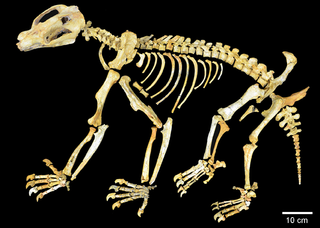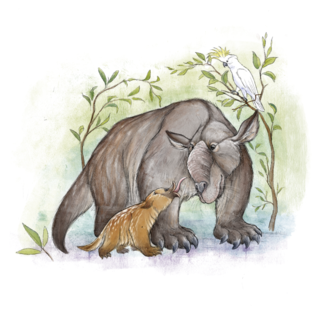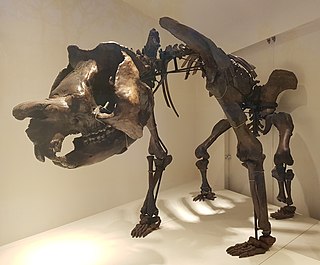
Diprotodon is an extinct genus of marsupial from the Pleistocene of Australia containing one species, D. optatum. The earliest finds date to 1.77 million to 780,000 years ago but most specimens are dated to after 110,000 years ago. Its remains were first unearthed in 1830 in Wellington Caves, New South Wales, and contemporaneous paleontologists guessed they belonged to rhinos, elephants, hippos or dugongs. Diprotodon was formally described by English naturalist Richard Owen in 1838, and was the first named Australian fossil mammal, and led Owen to become the foremost authority of his time on other marsupials and Australian megafauna, which were enigmatic to European science.

The Phascolarctidae is a family of marsupials of the order Diprotodontia, consisting of only one extant species, the koala, and six well-known fossil species, with another six less well known fossil species, and two fossil species of the genus Koobor, whose taxonomy is debatable but are placed in this group. The closest relatives of the Phascolarctidae are the wombats, which comprise the family Vombatidae.

The Vombatiformes are one of the three suborders of the large marsupial order Diprotodontia. Seven of the nine known families within this suborder are extinct; only the families Phascolarctidae, with the koala, and Vombatidae, with three extant species of wombat, survive.

Thylacoleo is an extinct genus of carnivorous marsupials that lived in Australia from the late Pliocene to the Late Pleistocene, often known as marsupial lions. They were the largest and last members of the family Thylacoleonidae, occupying the position of apex predator within Australian ecosystems. The largest and last species, Thylacoleo carnifex approached the weight of a lioness. The estimated average weight for the species ranges from 101 to 130 kg.

The term Australian megafauna refers to the megafauna in Australia during the Pleistocene Epoch. Most of these species became extinct during the latter half of the Pleistocene, and the roles of human and climatic factors in their extinction are contested.

Thylacoleonidae is a family of extinct carnivorous diprotodontian marsupials from Australia, referred to as marsupial lions. The best known is Thylacoleo carnifex, also called the marsupial lion. The clade ranged from the Late Oligocene to the Late Pleistocene, with some species the size of a possum, while members of Thylacoleo reached sizes comparable to living big cats.

Palorchestes is an extinct genus of large terrestrial, herbivorous Australian marsupial of the family Palorchestidae, living from the Miocene through to the Late Pleistocene. Like other palorchestids, it had highly retracted nasal region suggesting that it had a prehensile lip, as well as highly unusual clawed forelimbs that were used to grasp vegetation.

Protemnodon is an extinct genus of megafaunal macropodids that existed in Australia, Tasmania, and New Guinea in the Pliocene and Pleistocene. Members of this genus are also called giant kangaroos.

Nimbadon is an extinct genus of marsupial, that lived from the Late Oligocene to the Miocene epoches. Many fossils have been found in the Riversleigh World Heritage property in north-western Queensland. It is thought to have an arboreal lifestyle.

Palorchestidae is an extinct family of vombatiform marsupials whose members are sometimes referred to as marsupial tapirs due to the retracted nasal region of their skulls causing them to superficially resemble those of true tapirs. The idea that they had a tapir-like trunk has been contested, with other authors contending that it is more likely that they had a prehensile lip and protrusible tongue instead. While earlier representatives like Propalorchestes had relatively unspecialsed forelimbs, the last member of the family, Palorchestes developed unusual clawed forelimbs with a morphology unlike that of any living animal, which were likely used to tear vegetation. They are suggested to have been browsers. The group experienced an increase in body size over time, with Propalorchestes weighing around 150 kilograms (330 lb), while the last known species, Palorchestes azael may have exceeded a ton. They are considered to be members of Diprotodontoidea, most closely related to the also extinct Diprotodontidae. Their closest living relatives are wombats.

Phascolonus is an extinct genus of giant wombat known from the Pliocene and Pleistocene of Australia. There is only a single known species, Phascolonus gigas, the largest wombat ever known to have existed, estimated to weigh as much as 200 kg or 360 kg (790 lb). It was described by Richard Owen in 1859. Phascolomys magnus is a probable junior synonym. P. gigas is distinguished from other wombats by its strap-shaped upper incisors. The cranial roof is noticeably inwardly depressed. The species was abundant across Australia, with remains having been found in all states except Western Australia. It is suggested to have had a preference for arid and semi-arid inland habitats, with a diet consisting of a high amount of low quality vegetation. Though it likely had wide home-ranges, it probably did not stray far from fresh water sources. Abundant remains have been found in Pleistocene aged deposits from Lake Callabonna in South Australia. Unlike its living relatives, it is unlikely that Phascolonus engaged in burrowing. Phascolonus disappeared during the Late Pleistocene Quaternary extinction event around 50-40,000 years ago, together with many other large Australian animals, following the arrival of humans to the Australian continent. Phylogenetic analysis suggests that is closely related to the other giant wombat genera Ramsayia and Sedophascolomys.

Zygomaturus is an extinct genus of giant marsupial belonging to the family Diprotodontidae which inhabited Australia from the Late Miocene to Late Pleistocene.

Hulitherium tomasetti is an extinct zygomaturine marsupial that lived in New Guinea during the Pleistocene. The species name honours Berard Tomasetti, a Catholic priest in Papua New Guinea, who brought the fossils to the attention of experts.

Euryzygoma is an extinct genus of marsupial which inhabited humid eucalyptus forests in Queensland and New South Wales during the Pliocene of Australia. Euryzygoma is believed to have weighed around 500 kg, and differed from other diprotodonts in having unusual, flaring cheekbones that may have been used either for storing food or for sexual display. Euryzygoma is thought to be the ancestral genus from which Diprotodon evolved.

Nototherium is an extinct genus of diprotodontid marsupial from Australia and New Guinea. This marsupial had hypsodont molars and weighed around 500 kg. It was a relative of the larger Diprotodon and a distant kin to modern wombats.
Warendja is an extinct genus of wombat. It is known from two species, W. encorensis from the Late Miocene Riversleigh site in Queensland, and W. wakefieldi known from the Pleistocene of South Australia, New South Wales, and Victoria. The two species are primarily distinguished by features of their enamel. It became extinct as part of the Quaternary extinction event. Warendja wakefieldi is estimated to have weighed about 10 kg, considerably smaller than living wombats. Warendja thought to be relatively basal amongst wombats, being the most primitive member to possess hypselodont cheek teeth. The morphology of the humerus of W. wakefieldi suggests that it engaged in scratch-digging.
Ngapakaldia is an extinct genus of diprotodontid marsupials, related to the modern koala and wombat. Around the size of a sheep, it was a ground-dwelling herbivore that lived around the vegetated shores of lakes in Central Australia during the Late Oligocene.
Karen H. Black, born about 1970, is a palaeontologist at the University of New South Wales. Black is the leading author on research describing new families, genera and species of fossil mammals. She is interested in understanding faunal change and community structure in order to gain new understandings of past, current and future changes in biodiversity which are driven by climate.
Sedophascolomys is an extinct genus of wombat known from the Pliocene and Pleistocene of Australia. There is a single recognised species, S. medius, which was formerly placed in the invalid genus Phascolomys. It was found in the northeastern and eastern regions of the continent. It is estimated to be somewhat larger than extant wombats, with a body mass of 70–75 kilograms (154–165 lb). The youngest remains of the genus date to the Late Pleistocene, around 50–40,000 years ago. It is thought to be closely related to the giant wombat genera Phascolonus and Ramsayia.

Ambulator is an extinct genus of marsupials belonging to the family Diprotodontidae. It contains one species, A. keanei, whose remains were found in the Pliocene-aged Tirari Formation of South Australia. A. keanei was previously included in the genus Zygomaturus, but was moved to the new genus Ambulator in 2023. Features of its limbs suggest that Ambulator was better adapted to quadrupedal walking than earlier diprotodontids.

















